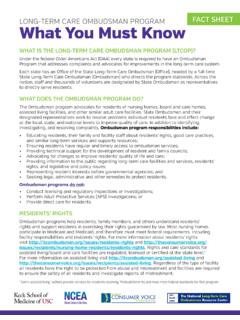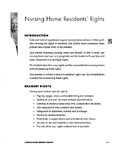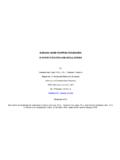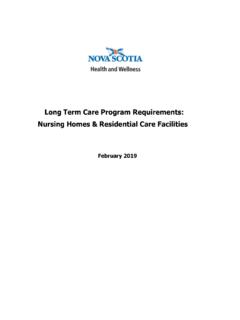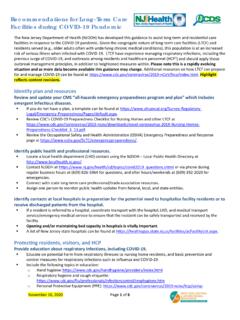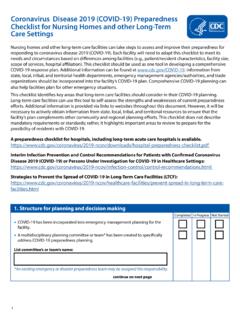Transcription of NURSING HOMES: WHO OWNS THEM? - ltcombudsman.org
1 NURSING HOMES: WHO OWNS THEM? Prepared by Ana Rivas-Beck National long Term care Ombudsman Resource Center April 2001 Supported by the Administration on Aging NURSING HOMES: WHO OWNS THEM? Prepared by Ana Rivas-Beck, Law and Policy Specialist National long Term care Ombudsman Resource Center April 2001 This report was supported, in part, by a grant, No. 90AM2139 from the Administration on Aging, Department of Health and Human Services. Grantees undertaking projects under government sponsorship are encouraged to express freely their findings and conclusions. Points of view or opinions do not, therefore, necessarily represent official Administration on Aging policy.
2 Table of Contents Introduction 1 Why Identify NURSING home Owners? 1 Tracking NURSING home Ownership 2 Step One: How to Identify the Owner 3 Step Two: Investigating the NURSING home Owner 4 Searching Public Corporations 4 Searching Private Corporations 6 Financial and Investment Reports 7 Policy Recommendations 9 Acknowledgements 10 Appendices Appendix A: Form 10-K Sample Appendix B: Form 10-Q Sample Appendix C.
3 Form 8-K Sample Appendix D: Form 3 Sample 1 NURSING Homes: Who Owns Them? INTRODUCTION Over half of NURSING home residents in the United States reside in facilities owned by a NURSING home corporation. These corporations are usually large chains that own facilities across the country, and the facilities are sometimes owned by the chain's subsidiaries or leased out to a management company. When ombudsmen, families, and other advocates attempt to identify or gather business and financial information on one of these corporations, they discover that it is complicated and even impossible since many NURSING home proprietors are part of a complex corporate structure.
4 Consumer advocates also find that it is not easy to locate these records because they are not all filed with one federal agency. Federal laws only apply to publicly held corporations (those that trade stock on public stock exchanges) -- all other corporations file their business and financial information with state agencies, which are governed by state laws. Finally, information published by private businesses that do provide corporate information for both publicly and privately held companies is often too expensive for the average consumer to purchase. This, however, should not stop advocates from identifying and tracking information on a corporation s profitability and growth plans; diversification in other businesses; executives and owners; and track record in providing good quality care in their facilities across the country.
5 Consumers and advocates have found that by tracking information on a NURSING home corporation, they can communicate their concerns directly to the decision makers of the NURSING home company and are assured that the executives and owners are fully knowledgeable that families, residents and advocates find them ultimately responsible for the care received by residents living their facilities. This report will attempt to address all these concerns by identifying sources that report on corporate business dealings and financial transactions. It will discuss (1) why there is a need for identifying NURSING home ownership; (2) provide a guide for tracking NURSING home owners and managers at both the federal and state level; and (3) provide policy recommendations for creating a more practical and effective system for consumers and advocates to collect this information on corporate owners and operators.
6 WHY IDENTIFY NURSING home OWNERS? Consumer advocates often need to identify NURSING home owners and operators to help change a facility s practices and improve the care provided to residents. State long term care ombudsman programs have used NURSING home ownership information to stop poor providers from expanding their business and to assist consumers in investigating their loved one s NURSING home . For example, the Oklahoma long term care ombudsman program used the number of complaints filed against a facility to testify against the owner s application to open a new facility. The testimony caused the state to deny the owner s request.
7 It also led to the development of a public report by the ombudsman program that listed the number of complaints filed against facilities and the name of the facilities' owners. The report eventually resulted in the closing of several facilities run by poor providers. 2 NURSING Homes: Who Owns Them? In Michigan, the ombudsman used facility owner data to help families and residents report problems directly to the owners. Rather than just communicating problems to the administrator, the residents and family members wrote the owners about their grievances, and they found that the facilities took quicker action to correct the harm.
8 In Ohio, regional long -term care ombudsmen are collecting information on corporations that own facilities within their area. The ombudsmen gather information such as complaints against the corporations facilities, the number of facilities owned in the area, corporate officers, and other pertinent information on the corporation. The Ohio state ombudsman is now working on developing a network among regional ombudsmen and the state ombudsman office to share corporate information and keep track records of corporations ability to provide good quality care to their residents throughout the state.
9 Unions also use corporate information to improve their leverage in labor disputes with NURSING home owners. The Service Employees International Union s national headquarters, for example, keeps a database that continuously identifies the name of NURSING home owners for all facilities in the The information is then made available to local union chapters so that they can effectively monitor owners and advocate for better working conditions for union employees and improve care for residents. For average consumers and advocates, however, and even ombudsmen, collecting information on NURSING home owners can be expensive and time-consuming since there is no easy step to finding information on a particular company.
10 Since the Securities Exchange Commission does not require all corporations to file reports and there are fifty different state laws governing NURSING home corporations, it is a challenge to develop an inexpensive system to gather companies business and financial records. TRACKING NURSING home OWNERSHIP Federal laws require that large publicly traded corporations file financial and corporate information with the federal government. Companies that (1) issue stocks for sale to the public; (2) have more than 500 shareholders; and (3) have more than $10 million in total assets must meet reporting requirements set by the Securities and Exchange Commission (SEC), an agency whose mission is to protect investors and maintain the integrity of the securities market.

